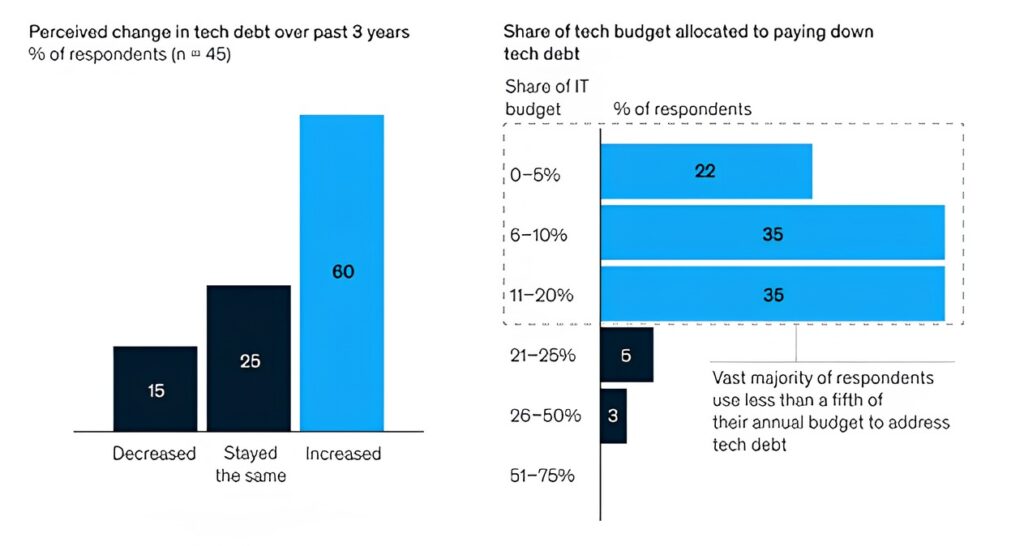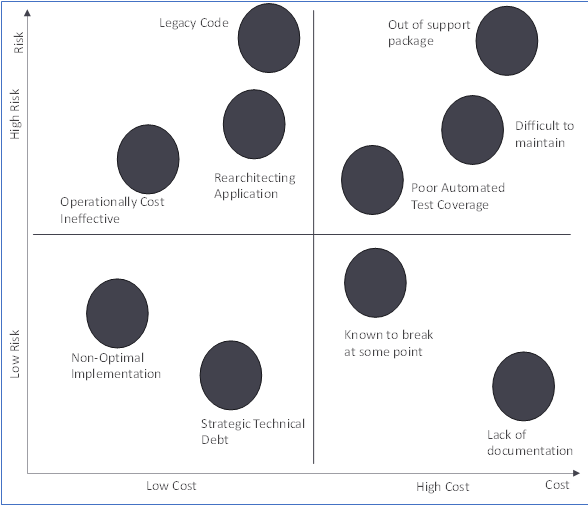Introduction
Technical debt is the hidden challenge that can hinder innovation and growth. As organizations scale, managing this ‘white elephant’ becomes critical to ensure long-term agility, efficiency, and sustainable development. For instance, outdated codebases that require constant patching can slow down product releases, diverting resources away from innovation and new feature development.

How to asses and categorize your technical debt
Assessing and categorizing technical debt involves identifying areas where outdated code, quick fixes, or inefficient architectures exist. This can be done through code reviews, analyzing bug frequency, and tracking development time spent on maintenance. Categorize debt into high, medium, and low priorities based on its impact on performance, scalability, and team productivity.

Types of Technical Debt
Here are several types of technical debt, each with unique implications:
- Deliberate Debt: Intentional shortcuts taken for speed, knowing they need to be fixed later (e.g., skipping tests for faster releases).
- Accidental Debt: Arises unintentionally due to lack of knowledge or experience, often from choosing suboptimal designs or technologies.
- Outdated Code Debt: Accumulates from using deprecated technologies, libraries, or frameworks that are no longer maintained, making updates difficult.
- Architectural Debt: Occurs when the software’s architecture isn’t flexible enough to accommodate new features, leading to scalability challenges.
- Code Debt: Results from poor coding practices, such as lack of documentation, complex or redundant code, and insufficient testing.
- Infrastructure Debt: Stems from outdated hardware or inefficient deployment processes, impacting system performance and maintenance.
- Process Debt: Develops when development processes aren’t optimized, like manual deployments or slow feedback loops, leading to inefficiencies.
Impact of Technical Debt
Technical debt can significantly impact an organization’s long-term success. Beyond just slowing development, it introduces risks and inefficiencies across various areas, affecting everything from security to team morale and financial stability.
- Heightened Risk Exposure
Technical debt often results in outdated systems that are more susceptible to security breaches and bugs. As patches and updates are delayed, the system becomes an easy
target for cyberattacks, putting critical data at risk and exposing the organization to compliance issues. - Sluggish Team Efficiency
Teams spend more time maintaining and fixing old code, slowing down development velocity. This reduces the time available for new feature development, causing delays in project delivery and leading to higher operational costs. - Innovation Roadblocks
Technical debt limits the capacity to integrate new technologies or explore innovative solutions. When resources are tied up in maintaining old systems, it becomes challenging to adapt to changing market needs, making it harder for organizations to stay competitive. - Deteriorating Customer Experience and Brand Image
Slow performance, bugs, or downtime caused by technical debt can frustrate customers. When users encounter issues or delays, it can erode trust and damage the company’s brand reputation, resulting in churn and negative reviews. - Chaotic or Unstable Codebase
Accumulated technical debt can lead to a tangled codebase that is difficult to understand, maintain, and expand. This results in higher defect rates, increased time for
debugging, and a lack of confidence in the stability of the system. - Team Fatigue and Frustration
Managing technical debt can create stress and frustration for development teams, as they are forced to work within the constraints of outdated systems. It can lead to
burnout and lower morale, reducing the overall effectiveness of the team. - Budget Drains
Technical debt can become a significant financial l burden over time. The costs of maintaining and patching old systems.
AI-Driven Approach for Removing Technical Debt
Leveraging AI to tackle technical debt can streamline processes and ensure more efficient remediation. Here’s how AI can help:
- Automated Code Analysis: AI tools can analyze codebases to identify issues like duplicated code, complex logic, or potential bugs. By highlighting problematic areas, they help developers focus on high-impact fixes, reducing time spent on manual code reviews.
- Intelligent Refactoring Suggestions: Machine learning models can suggest refactoring options to simplify complex code structures. These recommendations can improve code readability and maintainability, making the codebase more adaptable to future changes.
- Predictive Maintenance: AI can predict areas of the codebase likely to accumulate debt in the future based on past trends, usage patterns, and bug reports. This proactive approach allows teams to address issues before they become major bottlenecks.
- Automated Testing and Quality Assurance: AI-powered testing tools can generate test cases, run regression tests, and detect code vulnerabilities. This ensures that new changes don’t introduce additional technical debt, helping to maintain a cleaner, more robust codebase over time.
- Natural Language Processing for Documentation: AI tools using NLP can automatically generate or update code documentation, making it easier for developers to understand existing code and reducing the debt that comes from poor documentation practices.
- Prioritization and Resource Allocation: AI can analyze the severity and impact of technical debt items and help prioritize them based on their business impact. This enables
organizations to allocate resources efficiently, focusing on the most critical areas first. - Continuous Integration and AI-Powered Code Reviews: Integrating AI-driven code review tools into the CI/CD pipeline ensures that new changes align with best practices, reducing the chance of accumulating more debt. This keeps the codebase clean as it evolves. By adopting an AI-driven approach, organizations can not only reduce existing technical debt but also prevent new debt from forming, ensuring a more agile and scalable development process.
Conclusion
Managing technical debt is essential for ensuring the long-term health and scalability of software systems. While it’s often easy to accumulate debt in the pursuit of rapid development, the costs can add up quickly, impacting productivity, innovation, and customer satisfaction. A structured approach to assessing and addressing technical debt, supported by AI-driven tools, offers a practical path forward. By automating code analysis, refactoring suggestions, and testing, organizations can stay ahead of technical debt, focusing resources where they matter most. Ultimately, reducing technical debt through these methods not only enhances system performance but also empowers teams to
innovate, respond to market changes, and deliver better products with confidence.
